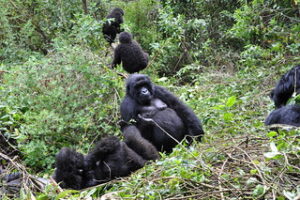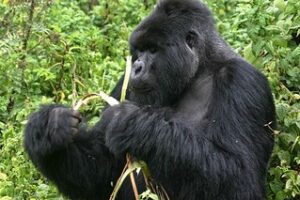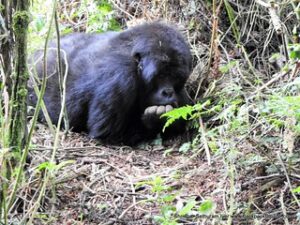An amazing journey right in the middle of Africa, gorilla trekking presents a unique chance to see the closest living cousins of human in her natural habitat. Mostly occurring in Uganda, Rwanda, and the Democratic Republic of Congo (DRC), this experience entails endangered mountain gorilla observation and interaction by means of a hike across deep forests. Because of its special mix of adventure, conservation relevance, and great wildlife encounter, the Endeavor is sometimes seen of as a once-in- a lifetime event that will leave you and the gorilla community not the same. Pack your suits and prepare for this great Endeavor
Appreciating Gorilla Trekking
Mountain gorillas, a subspecies of the eastern gorilla, call the rich woods and volcanic slopes of the Virunga Massif that is made up of Mgahinga National Park in Uganda, Volcanoes National Park in Rwanda and Virunga National Park in Congo and Bwindi Impenetrable Forest of Uganda home. With just over 1,000 wild individuals across the world, these magnificent animals are critically endangered. Their ecosystem is delicate and under threat from human development; so, responsible travel is essential for their survival.
Usually starting early in the morning, gorilla trekking starts with a briefing by park rangers detailing safety rules and offering analysis of gorilla habits and conservation initiatives that are in place. Then small groups of visitors usually of 8 people hunt the forest for gorilla families, guided and tracked alongside. The location of the gorilla groups will determine the length and intensity of the trip; it usually ranges between 1 hour to 8 hours of trekking across demanding terrain.
Once a gorilla troop is found, trekkers are given 1 hours of interacting and observing gorilla behavior from about 7 meters. This close-up provides a unique window into their daily activities including grooming, feeding, and socializing. Seeing these strong but delicate animals in their native habitat creates a personal connection that cuts across human and animal lines that is rather poignant.
Along with regular hiking, Bwindi, Virunga, Volcanoes and Mgahinga National parks offer gorilla trekking, researchers and guides adapt gorillas to human presence while spending long times with a gorilla family undergoing habituation (this is a special program that can go beyond the usual arrangement of 1 hour interaction with gorillas.). Though it takes more time and is more expensive, this experience provides a closer knowledge of these amazing species.
Affordability and Approval
Authorize Expenses
The main cost connected with this trip is a gorilla trekking permit, which differs depending on the country:
Rwanda: permits cost $1,500 USD per person.
Uganda: permits cost at $800 per person.
Democratic Republic of Congo (DRC): The price of permit is $400
By means of anti-poaching patrols, habitat preservation, and community development initiatives, permit fees directly support conservation activities, therefore guaranteeing the long-term existence of mountain gorillas and their habitats.
Extra Spending
Apart from permission fees, other expenses could be lodging, travel to the park, guide and porter tips, and maybe visa fees depending on your country and destination.
Why gorilla trekking worth the fortune?
Conservation Influence gorilla trekking
Not only a tourist pastime, but gorilla trekking is also a pillar of conservation work. Permission income directly supports habitat protection, anti-poaching programs, and community development projects. Through gorilla trekking, guests actively help to preserve these threatened species and their habitats. so, guaranteeing that future generations will also be able to marvel at seeing wild gorillas.
Original Wildlife Experience for gorilla trekking
Seeing mountain gorillas in their native environment is a moving and modest event. It presents a unique chance to see personally the complexity of gorilla social systems, behaviors, and interactions with their surroundings. This close-up experience motivates personal relationships with these amazing creatures and helps one to appreciate wildlife protection.
Financial Benefits for Local Areas
Local communities gain greatly economically from gorilla tourism, which generates jobs in hospitality, guides, porters and other support businesses. Many lodges and tour companies give sustainable practices and community partnerships top priority. so, ensuring that residents directly gain from tourism income and so encourage environmental care and wildlife protection.
Educational and Motivating Worth
Apart from its environmental preservation and financial effects, gorilla walking offers guests a life-changing opportunity. It raises knowledge of issues related to the preservation of world biodiversity. It also motivates people to start campaigns for animal protection. Along with trekking experiences. Education initiatives help to deepen knowledge of environmental problems. It also helps to deepen the need of sustainable travel policies to such animal that are in danger due to poor practices.
Conclusion.
More than just a window into the life of mountain gorillas. Gorilla trekking and habituation experiences reflect a dedication to conservation, ethical travel, and cultural interchange. Although the cash outlay seems significant. The benefit of seeing these amazing animals in their natural habitat and helping their survival is almost impossible to overestimate. With that one trip to visit gorillas, you will be able to contribute on their survival




